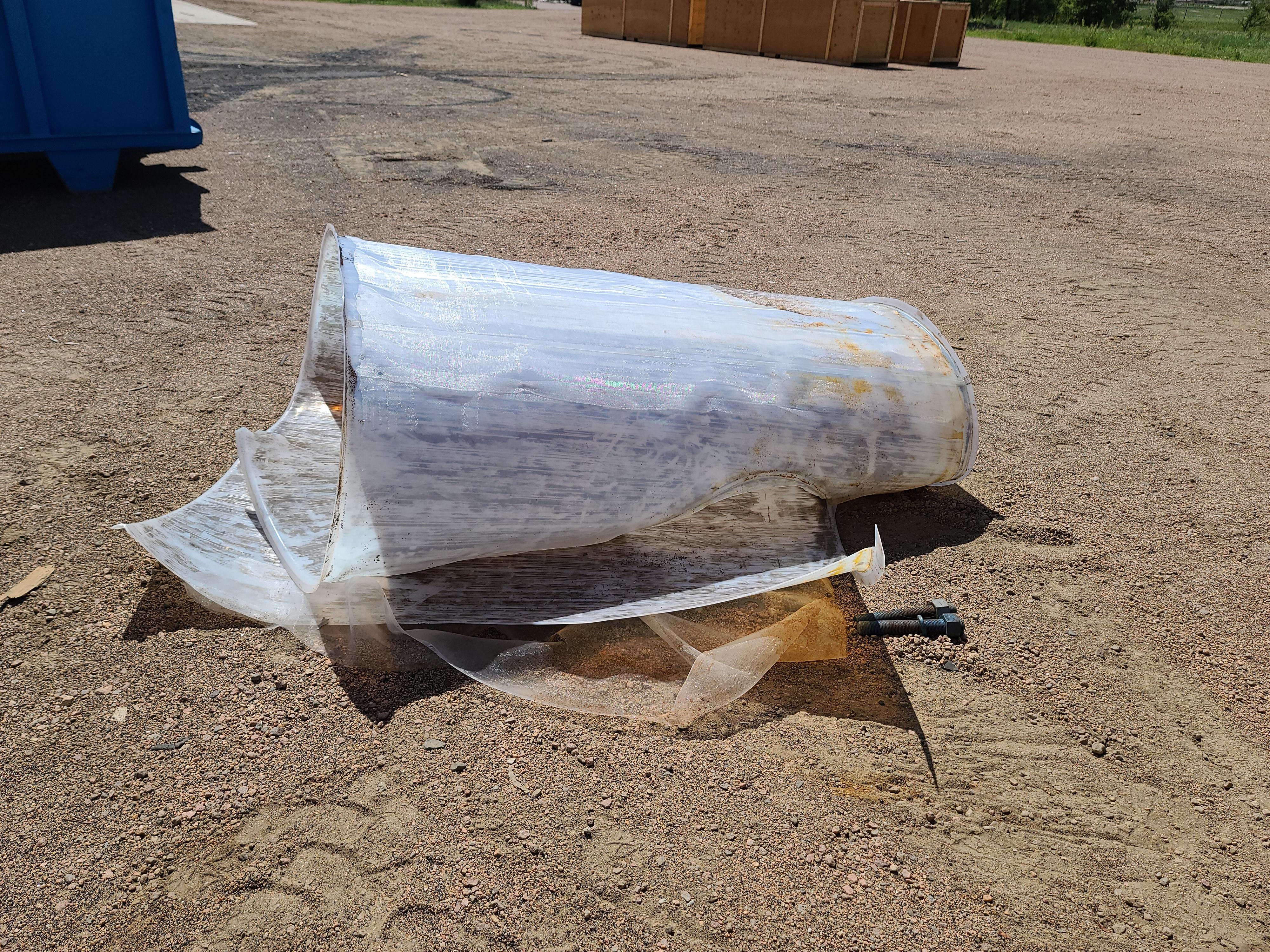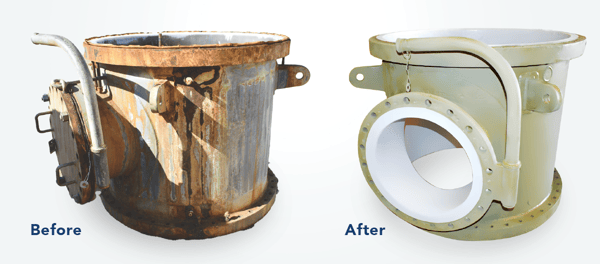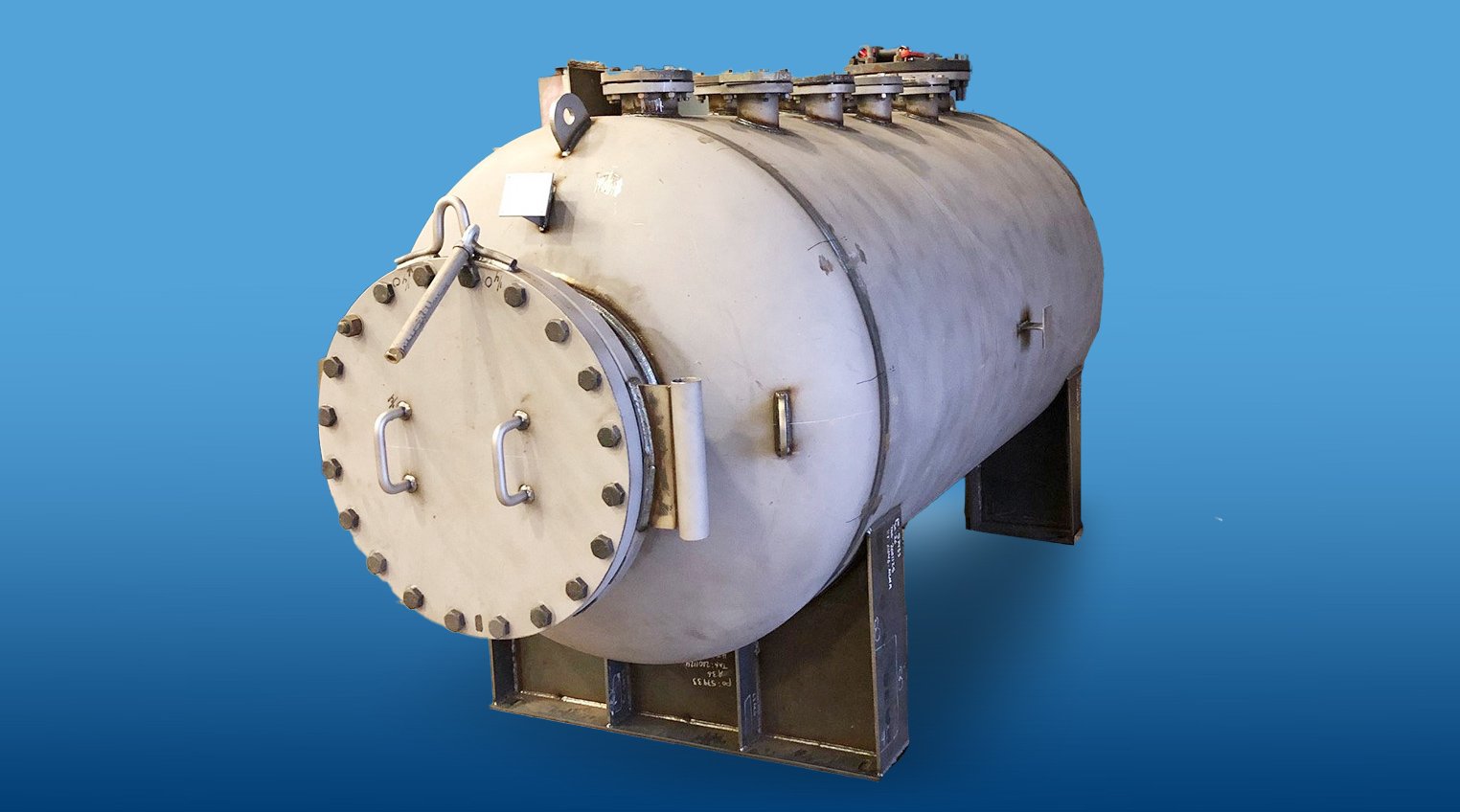6 Ways That Rotational Lining Is Better Than Sheet Lining
Managers at a vinyl chloride monomer plant were worried. They knew their stripping column was leaking, and corrosion was visible from the outside. Upon inspection, they could see that the polytetrafluoroethylene (PTFE) sheets used to line the column segments had failed, allowing reactive process fluid to corrode the carbon steel body of the column. When they contacted RMB, the situation was critical. It was clear that many of the nozzles and vent holes would need to be repaired or replaced.
This unfortunate situation illustrates a common reason why companies decide to switch from sheet liners to rotational liners. While sheet lining has some benefits, engineers should understand the ways that rotational lining, or rotolining, is often a better choice.
What is Sheet Lining?
To protect metal process equipment from acidic or alkali chemicals, the equipment is lined with a polymeric material. Technicians take sheets of plastic, about 3 millimeters thick, and glue them to the internal walls of a process vessel or pipe. Sometimes the sheets are loose, not glued down except around ports. The sheets are mass produced in set sizes, so technicians must tailor-cut the sheets to fit the configuration of the vessel. After the sheets are in place, the seams are plastic-welded. Often ample lining is left sticking out of an opening so the sheet can be attached to the flange using screws or flared and left unbonded.
There is another kind of lining made of pre-molded PTFE that is inserted into a vessel or pipe. It’s inexpensive for standard size pipes, but it’s costly for custom shaped vessels and pipe assemblies. This blog post focuses on sheet lining rather than pre-molded linings.
How Sheet Liners Fail
Sheet liners fail in predictable modes based on several factors.
- Weld joints
- Permeation and corrosion
- Pressure limits
- Temperature limits
A review of each failure mode follows along with comparisons to the performance of a rotational lining in the same conditions.
6 Reasons Why Rotolining Is Better
- Weld Joints
The plastic welds between sheets and at nozzles are vulnerable to failure, because they are a weak point in the system. Their strength will never match that of the parent material, and the adhesion to the substrate will not be as secure in the area of the welds. As the seams are made by hand, each weld provides a potential point of failure. When the liner sees the high temperatures and temperature-cycling common to chemical processing, the plastic welds will be the limiting factor of the system.
In contrast, a rotational lining is mechanically bonded to the interior surface of the vessel. It provides a monolithic layer of protection that is virtually free of stresses.
- Permeation and Corrosion
A sheet liner puts a relatively thin layer of protection between the process fluid and the vessel body. Sheet thickness ranges from 0.090 to 0.150 inches. This is thin enough that aggressive chemicals can permeate the liner in the form of gas, especially at plastic-welded seams.
In the design mentioned at the start of this post, the engineers planned for this by adding PFA mesh beneath a loose sheet liner and adding vent holes to the body of the column stripper. Although the column was coated with a 0.0197-inch layer of PFA, the gas was corrosive, and—along with fluid leaks—it contributed to corrosion of the column structure, especially the areas around the vent holes.
Rotational liners are much thicker than sheet liners, offering better corrosion protection. Thicknesses range from 0.125 to 0.450 inches, depending on the requirements of the service application. The corrosion protection liner polymer material is thick enough to prevent permeation and corrosion. In addition, because a rotational liner is mechanically bonded to the surface, there will be no unintended annular spaces or gaps where permeation can collect and condense.
- Pressure Limits
Sheet linings have pressure capabilities limited by the tensile strength of the sheet material, compared to linings and coatings that are mechanically bonded to the surface. Vacuums pose a distinct threat to sheet-lined vessels because a vacuum can cause the sheet to separate from the adhesive.
Rotolining provides a tight mechanical bond between the polymer material and the surface. The bond is stronger than the tensile strength of the material. It performs reliably in high pressure and vacuum applications.
- Temperature Limits
The adhesive used to attach a sheet liner to the vessel does not have as high a temperature rating as the sheet liner. In effect, this places a ceiling on the operating temperature, which in practice, is often exceeded in the application. Over time, excessive heat can cause the adhesive to fail, resulting in loose sheets that are more vulnerable to the forces of flow and pressure.
In contrast, a rotationally applied liner needs no adhesive. Its temperature service range is equal to the full operating temperature of whatever material is specified for the application. For example, PFA is rated for operation at 250 degrees C.
Other considerations: Deciding which lining technology to use goes beyond the risk of liner failure. Engineers need to consider how the liner is installed and the total cost of ownership.
- Complex Geometries
The material used for sheet lining comes in flat sheets having limited flexibility, making it difficult to adapt them to the shape of vessel interiors. In many cases, it is difficult for a worker to reach all interior surfaces during installation, even when a manway is available. Where there are complex geometries, workers will be challenged to fit the sheets precisely, increasing the need for seams and increasing the likelihood that the sheet will not have adhered evenly to the interior surface of the vessel. In pipes, hard-to-line spots include elbows, tees, and neckdowns.
The rotolining process avoids these challenges. A pipe or vessel is placed inside a large oven, and polymeric resin is placed inside the vessel. As the resin melts, it flows over surfaces and coats them. The oven slowly rotates in two dimensions to ensure the lining is evenly applied to all interior surfaces. Complex shapes, including features such as nozzles and outlets, are easily and consistently lined.
- Cost
Sheet lining and rotational lining have a comparable upfront cost depending on the size and complexity of the equipment. Because of competition between suppliers, loose sheet lining will usually be cheaper than rotational lining. Sheet liners that are hand cut, glued and seam-welded will likely cost more than rotational liners. However, the cost per service year of the two technologies is quite different when life expectancy is put into the equation.
One RMB customer, a processor of quartz and silica, was replacing PTFE linings every three to six months because of the wear of the abrasive media and permeation of the corrosive acid. When they switched to rotolining, the service life of each lined vessel increased to two to three years. A significant savings in costs of operation as well as maintenance were discovered.
Summary
Most of engineering is about weighing tradeoffs, and protective linings are no different. For example, sheet liners can be installed or repaired in the field. Not so with rotational lining, which requires vessels to be shipped to the supplier for lining in a large customized rotolining oven.
Engineering managers should evaluate the specifics of each maintenance situation and each design project, including the type of processing fluid, the pressures and temperatures involved, the complexity of vessel interiors, and the impact of downtime.
At the vinyl chloride monomer plant, the managers evaluated all of these points. They decided to switch to rotational lining, rather than replace the sheet liners. In a short turnaround time, RMB was able to roto-line damaged segments of the stripping column and repair damaged nozzles. The managers expect the restored column to provide years of worry-free service.
Learn More
Contact us to learn more about how rotational lining can benefit your application.





